Jessica Donegan's Blog, page 2
March 10, 2020
Post Book Launch: Reflections
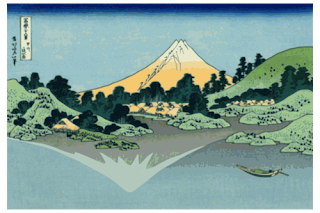 from publicdomainvectors.org
from publicdomainvectors.orgI had a bad cold rolling into the launch of “Follow Me: Tattered Veils.” It kept me from being as active on social media as I’d planned. It kept me from feeling either excited or nervous. Most of me just wanted everything to be over. It felt like a slow grind towards an inevitable conclusion. I wasn’t even a little happy, and I don’t feel different now that we launched the book.
The one bright side to my illness is I also don’t feel let down. All this time I’ve been pushing for a strong release of “Follow Me: Tattered Veils” and bracing for silence. It’s been hard to stay so positive and strong while trying to keep expectations low. Realistically, only my friends, family, and husband’s friends/family will read or buy this book. And that stings because I’ve gone way out of my comfort zone to promote this book. I’ve spent a lot of time and energy trying to be friendly and charming and trying to find the right audience to enjoy my book. And I love “Follow Me: Tattered Veils” like it’s a living person and part of me feels like I’ve failed her. I’m like that parent that couldn’t figure out how their kid’s skill set could land them a successful career… or I saw that potential, but I couldn’t steer the kid in the right direction.
Now that I’m recovering from the cold, I feel like there’s all this lost time to make up for. I’ve got all these posts on writing and goals I have for 2020, and I haven’t hit most of them. I have to face it: I won’t meet a lot of my goals (writing and otherwise). And it’s leaving me feeling desperate to make up for lost time.
I’m anxious to write, and it’s been so long, the creative writing part of my brain feels rusty and misused.
So now you want me. When I was romping and playing in the background, shouting for you to stop and write, you didn’t have time or you felt too sick, but now you want me just to appear on demand. Well, good luck.
People talk about “recovering from the book launch” and I’m sitting here and laughing because I am literally recovering from being sick as much as the nerves of the launch and the pressure to be “on”. But some things I’m trying to keep in mind as I move forward:
1. Be kind to me. There’s stuff that’s fucked up this book and it’s too late to take it back. I need to forgive myself for any missteps or things I didn’t do or know to do for this launch.
2. Don’t linger. I need to get up and move the fuck on. I’ve got two major drafts I’m working on. I have a novella I’d love to find a sensitivity beta reader for and I would love love love love love to self publish it. I work a full-time job, I have a dog and a husband and I have all this work I want to do. I can’t wallow in lost time. And I can’t wait for my creative side to be ready, I might need to force it a little until I find my routine.
3. The book is out and published. Same way I didn’t wake up and have a complete novel ready to publish, I can’t expect people just come in to buy it. It will be a war of attrition to make back the money spent or to get people to read and enjoy the book.
4. It’s not 100% over. I have a few more promotional blogs to write/publish. AND starting March 15th I launch “Roxi’s Podcast” where I do a read along for “Follow Me: Tattered Veils.” My intentions are to reward early adopters of this story with some further insight into the creation and meaning of the story AND to entice some readers who are on the fence. My team and I pre-recorded most of the podcasts, but we have at least two or three more to record.
Published on March 10, 2020 09:45
If You Like "The Forbidden Game" You Might like My Novel (minor spoilers for both works...though nothing that gives the stories away)
This
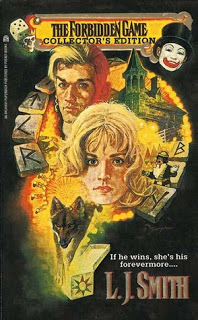 The original Forbidden Game book cover I picked up over a decade ago found via google.
The original Forbidden Game book cover I picked up over a decade ago found via google.
VS
This
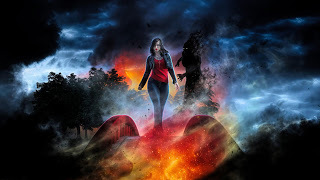 Follow Me: Tattered Veils wide image art work created by Jake @ J Caleb Designs
Follow Me: Tattered Veils wide image art work created by Jake @ J Caleb Designs
The Forbidden Game : A series by L. J. Smith about a highschool girl Jenny who's gained the attention of an immortal being, Julian. After many years of watching over and protecting Jenny, Julian lures her and her friends into his world through a board game. The group needs to make it to a tower before dawn to escape his clutches, but to do so they will have to each face their own worst nightmares.
What does this series and Follow Me: Tattered Veils share?
Gerry, like Julian has an obsession for the protagonist, Roxi and Roxi, like Jenny, is unaware of Gerry’s obsession until he enacts his plan to capture her. Both stories have a friend group whom the protagonist must save. Both characters romp through a supernatural world that doesn’t seem to follow any hard and fast rules.
The better question might be why two separate books for what feels like very similar ideas? It's hard to spell out the difference without spoiling each individual story, but I will try to hit some larger points.
Julian is portrayed in the first two books as an all powerful being. He is far more powerful the the human protagonists. However book three reveals Julian to be a young and far weaker member of his race. Book three also shows that Julian, who is portrayed as lacking empathy or emotion actually has more than he revealed and is an emo kid compared to the elders of his race.
Meanwhile, Gerry is the king of the fae. He is the most powerful of his people and expects praise, worship, and deference as his due. Gerry shows emotion often, it isn't alway in sync with how a human would react to a situation but he shows joy, amusement, boredom, anger, and frustration to mention a full range of emotions. There is no emotional moment where are tearful Roxi says something like "you don't care at all do you?" and Gerry smiles and shrugs, though Julian and Jenny get this moment multiple times in their work.
Jenny and Roxi are very different characters. Jenny's popular, has a long term boyfriend, and still in high school. Roxi is isolated and resents the society she lives in. Jenny is used to people and systems that work for her while Roxi is more used to fighting for things. This creates a harder protagonists vs one who can fall weepy at times.
Roxi is older than Jenny too. At twenty-three she stands in the "adult" camp, though her actions indicate she has some emotionally stunted growth related to an unrevealed past. Roxi sometimes acts with a younger character's immaturity but she never hesitates to take advantage of all the rights and privileges adulthood bestows. She doesn't answer to parents or any other authority structure.
Jenny is attracted and repelled by Julian at the same time. There is no romantic subplot between Roxi and Gerry. Some of this may be a when it was written and who the works were written for situation. There was a period in the 90s when a boy/ immortal being stalking you was considered very romantic, especially when written a certain way. I never agreed, so I'm thankful that now we call this kind of story out for promoting unhealthy creepy behavior.
The Forbidden Game is a young adult series, a good one adults may also enjoy, but the story beats, the scares, and so on are geared for a fourteen to seventeen audience. Follow Me: Tattered Veils is geared for a new adult audience. The situations, scares, and story beats are all for a more mature audience. I think if you like one series, you'll like the other too. And I'd love to do a more detailed post comparing and contrasting all the little tidbits, but I don't want to spoil a novel I haven't released yet!
Did you love The Forbidden Game? Were any of these elements you loved? If so consider picking up Follow Me: Tattered Veils when it releases in February. Check out my website jessicadonegan.com for more details.
Published on March 10, 2020 07:56
February 25, 2020
If You Like "The O.A." You Might like My Novel (spoilers for the show—not my novel)
This
 promotional imagery from The O.A. found via google
promotional imagery from The O.A. found via google
VS
This Follow Me: Tattered Veils wide image art work created by Jake @ J Caleb Designs
Follow Me: Tattered Veils wide image art work created by Jake @ J Caleb Designs
The O.A. : A Netflix show featuring a female protagonist who disappeared years ago and when she resurfaces, the once blind woman can see. Prairie, now referring to herself as the O.A. has been through something traumatic, but she won’t share with the FBI or her adopted family. Instead, she recruits four highschool students and a teacher whom she tells her story to and asks they help her save four other captives she left behind. Teeming with supernatural, scifi, and fantasy elements, the show is a slow burning mystery told at the survivor’s pace.
What does this series and Follow Me: Tattered Veils share?
Follow Me: Tattered Veils and The O.A. season one share a slow burn full of tension. Both stories unfold at the protagonist’s pace instead of the viewer’s desired speed or the speed the surrounding cast may prefer. The O.A. and Roxi make readers wait for it, but the release is all the sweeter because of the building.
Both the O.A. and Roxi have spiritual and esoteric knowledge the world around them doesn’t value. As their respective stories unfold, their knowledge gains value, and becomes the key to their ability to survive their situations.
Both The O.A. and Roxi share stories of strife and survival against all odds. Their antagonists have an insidious obsession with them and even when they break free of these men’s power, the men refuse to leave them alone. Questions of stalking, possession, and the toxicity of the male gaze are rife in the narrative.
Lastly both stories use established myth as a connecting foundation. Even though views consider these myths and not truths in their lives, the audiences' familiarity with the original myth helps to build credibility and a sense of realism to the experiences the O.A. and Roxi go through. Like an urban legend one might debate the validity of because a cousin's friend once said something like that happened to them, these old myths help ground the fantastic and bring it into the realm of possible. The O.A. uses angelic myths and after life experience stories to weave it’s narrative. Follow Me: Tattered Veils uses a collection of Italian, Greek, and Irish mythology to grow its own story.
Did you love The O.A.? Were any of these elements you loved? If so consider picking up Follow Me: Tattered Veils when it releases in February. Check out my website jessicadonegan.com for more details.
 promotional imagery from The O.A. found via google
promotional imagery from The O.A. found via googleVS
This
 Follow Me: Tattered Veils wide image art work created by Jake @ J Caleb Designs
Follow Me: Tattered Veils wide image art work created by Jake @ J Caleb Designs
The O.A. : A Netflix show featuring a female protagonist who disappeared years ago and when she resurfaces, the once blind woman can see. Prairie, now referring to herself as the O.A. has been through something traumatic, but she won’t share with the FBI or her adopted family. Instead, she recruits four highschool students and a teacher whom she tells her story to and asks they help her save four other captives she left behind. Teeming with supernatural, scifi, and fantasy elements, the show is a slow burning mystery told at the survivor’s pace.
What does this series and Follow Me: Tattered Veils share?
Follow Me: Tattered Veils and The O.A. season one share a slow burn full of tension. Both stories unfold at the protagonist’s pace instead of the viewer’s desired speed or the speed the surrounding cast may prefer. The O.A. and Roxi make readers wait for it, but the release is all the sweeter because of the building.
Both the O.A. and Roxi have spiritual and esoteric knowledge the world around them doesn’t value. As their respective stories unfold, their knowledge gains value, and becomes the key to their ability to survive their situations.
Both The O.A. and Roxi share stories of strife and survival against all odds. Their antagonists have an insidious obsession with them and even when they break free of these men’s power, the men refuse to leave them alone. Questions of stalking, possession, and the toxicity of the male gaze are rife in the narrative.
Lastly both stories use established myth as a connecting foundation. Even though views consider these myths and not truths in their lives, the audiences' familiarity with the original myth helps to build credibility and a sense of realism to the experiences the O.A. and Roxi go through. Like an urban legend one might debate the validity of because a cousin's friend once said something like that happened to them, these old myths help ground the fantastic and bring it into the realm of possible. The O.A. uses angelic myths and after life experience stories to weave it’s narrative. Follow Me: Tattered Veils uses a collection of Italian, Greek, and Irish mythology to grow its own story.
Did you love The O.A.? Were any of these elements you loved? If so consider picking up Follow Me: Tattered Veils when it releases in February. Check out my website jessicadonegan.com for more details.
Published on February 25, 2020 14:49
February 18, 2020
4 Ways I Use Sigils as a Writer
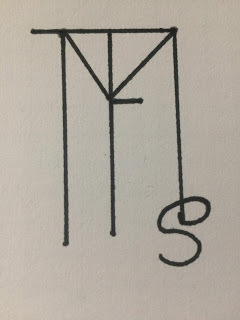 sigil for my word of the year "Manifest"
sigil for my word of the year "Manifest"While sigils have different uses historically, here we’re considering them symbols that represent another word or phrase. They embody a whole string of words or ideas in a more simplistic way.
The writer in me loves dead languages, codes, and creating whole cloth new words/ideas. It’s little wonder sigils have lasting appeal. Today I will cover 4 ways I use sigils to help me write.
1. I make sigils for my book titles (and working book titles) and it helps me get into the atmosphere of my books. So “Follow Me: Tattered Veils” is a mouthful, and its acronym FMTV feels ugly, plus the TV reminds me of television and I HATE that. So instead, I use a sigil for the book. Since I created the sigil, something about its flow and design helps me feel more true to the contents of the book. It looks like this:
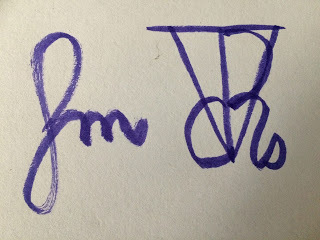
2. I make sigils for characters in my books. I’m not an artist. I make mediocre chibis sometimes, but nothing I’d share or want to represent my written ideas. You can make a collection of lines that look cool with little skill or time. So I collect the character’s name and defining traits and make a sigil from that, which represent the character in my outlines.
3. Sometimes I use sigils to refer to spoilers or different endings. Here’s the paranoid writer in me. I don’t like for people to see what I’m working on until I’m ready. Sometimes I use sigils to further obscure what I’m working on in case there is a casual person looking over my shoulder (my husband and I KNOW he doesn’t care, but I don’t want him to read even a stray word). But the symbols take on their own emotional resonance. They can help color the events of a story with their curves and points before I even write the scene.
4. Sigils can be motivational. I made a sigil out of my writers’ goals for the year and I look at them/doodle them just whenever. I reinforce those commitments and sometimes drives me back to them when I was clowning around.
Published on February 18, 2020 10:26
February 11, 2020
If You Like "American Gods" You Might like My Novel (mild spoilers for the book/show—not my novel)
This
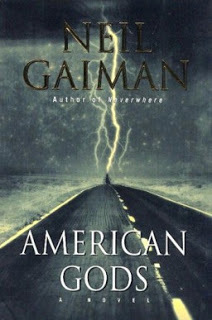 Original American Gods book cover.
Original American Gods book cover.
VS
This Follow Me: Tattered Veils wide image art work created by Jake @ J Caleb Designs
Follow Me: Tattered Veils wide image art work created by Jake @ J Caleb Designs
American Gods: is a novel by Neil Gaiman that's seeing a resurgence in popularity as a Starz TV show based on the book just finished its second season. The basic premise Shadow, upon his release from prison, agrees to work as a bodyguard to Mr. Wednesday. The two go on a road trip recruiting various associates of Mr. Wednesday. A bunch of stuff happens that I would spoil if I went any further. It’s a great supernatural/fantasy hybrid story that incorporates many kinds of storytelling.
What does this series and Follow Me: Tattered Veils share?
One element both this story and mine have in common is that the magical/supernatural world intertwines with the mundane world readers know. It’s happening next to us non-magical people and we’re just not looking at it.
In American Gods, gods and mythical creatures are just chilling on the human plane, working mundane jobs, and interacting with humans as they feel is best for their survival. The inhuman beings in Follow Me: Tattered Veils are like that too. They show up and bless or curse humans as they feel appropriate. And just because the characters’ have ended the summoning or the ritual, doesn’t mean the beings they called have left.
American Gods uses real road trip landmarks as mystical energy centric places for gods and supernatural creatures to gather. Since these places are real, readers can create their own American Gods style road trip if they desire, but it also helps to ground some more fantastic elements of the narrative in the real world. I went to Rock City because of how it’s featured in American Gods and how I experienced that place was impacted by Gaiman’s description. I’m aspiring to do the same for a few locations in Huntsville, Alabama.
The characters in American Gods and Follow Me: Tattered Veils have critical flaws. Sometimes the characters are down right unlikable. What drives a reader to keep going is how interesting they are, it's a different type of charisma. No one wants to sit down and have a beer with them, but they might be curious to see what the next move is anyway.
While never intended for this use, American Gods comes up a lot in American pagan discussions. There are a subset of polytheistic pagans in America who wonder what gods to honor. We don't have ancient land gods like our European cousins (we do, they are Native American deities but there is a whole side discussion over whether we should/can honor these gods and which gods apply to which territory/how we would verify this info with the still living Native peoples). I can't tell you how often "This is a bad land for gods," was quoted in a forum. While not a religious or theological texts, American Gods creates a jumping off point to start discussing what it would mean if there were multiple gods, if those gods had limited powers, and if those gods had a fluctuating morality.
Follow Me: Tattered Veils is a smaller, more personal story. It doesn't discuss the nature of gods and how they may exist in a non native landscape. Instead it tackles one woman modernizing an older practice to suit her lifestyle and it further tackles what happens when myths and legends are real and interacting with each other in the real world. I don't expect it to be an intro to paganism, but I do think it may open a conversation up on many magic and legend based topics.
Did you love American Gods? Have you read the book, watched the show, or both? Do you like the book or the show better? Were any of these elements parts you loved? If so consider picking up Follow Me: Tattered Veils when it releases in February. Check out my website jessicadonegan.com for more details.
Haven't read American Gods yet but want to now? Check it out at Amazon. Looking for the show? Look here.
 Original American Gods book cover.
Original American Gods book cover.VS
This
 Follow Me: Tattered Veils wide image art work created by Jake @ J Caleb Designs
Follow Me: Tattered Veils wide image art work created by Jake @ J Caleb DesignsAmerican Gods: is a novel by Neil Gaiman that's seeing a resurgence in popularity as a Starz TV show based on the book just finished its second season. The basic premise Shadow, upon his release from prison, agrees to work as a bodyguard to Mr. Wednesday. The two go on a road trip recruiting various associates of Mr. Wednesday. A bunch of stuff happens that I would spoil if I went any further. It’s a great supernatural/fantasy hybrid story that incorporates many kinds of storytelling.
What does this series and Follow Me: Tattered Veils share?
One element both this story and mine have in common is that the magical/supernatural world intertwines with the mundane world readers know. It’s happening next to us non-magical people and we’re just not looking at it.
In American Gods, gods and mythical creatures are just chilling on the human plane, working mundane jobs, and interacting with humans as they feel is best for their survival. The inhuman beings in Follow Me: Tattered Veils are like that too. They show up and bless or curse humans as they feel appropriate. And just because the characters’ have ended the summoning or the ritual, doesn’t mean the beings they called have left.
American Gods uses real road trip landmarks as mystical energy centric places for gods and supernatural creatures to gather. Since these places are real, readers can create their own American Gods style road trip if they desire, but it also helps to ground some more fantastic elements of the narrative in the real world. I went to Rock City because of how it’s featured in American Gods and how I experienced that place was impacted by Gaiman’s description. I’m aspiring to do the same for a few locations in Huntsville, Alabama.
The characters in American Gods and Follow Me: Tattered Veils have critical flaws. Sometimes the characters are down right unlikable. What drives a reader to keep going is how interesting they are, it's a different type of charisma. No one wants to sit down and have a beer with them, but they might be curious to see what the next move is anyway.
While never intended for this use, American Gods comes up a lot in American pagan discussions. There are a subset of polytheistic pagans in America who wonder what gods to honor. We don't have ancient land gods like our European cousins (we do, they are Native American deities but there is a whole side discussion over whether we should/can honor these gods and which gods apply to which territory/how we would verify this info with the still living Native peoples). I can't tell you how often "This is a bad land for gods," was quoted in a forum. While not a religious or theological texts, American Gods creates a jumping off point to start discussing what it would mean if there were multiple gods, if those gods had limited powers, and if those gods had a fluctuating morality.
Follow Me: Tattered Veils is a smaller, more personal story. It doesn't discuss the nature of gods and how they may exist in a non native landscape. Instead it tackles one woman modernizing an older practice to suit her lifestyle and it further tackles what happens when myths and legends are real and interacting with each other in the real world. I don't expect it to be an intro to paganism, but I do think it may open a conversation up on many magic and legend based topics.
Did you love American Gods? Have you read the book, watched the show, or both? Do you like the book or the show better? Were any of these elements parts you loved? If so consider picking up Follow Me: Tattered Veils when it releases in February. Check out my website jessicadonegan.com for more details.
Haven't read American Gods yet but want to now? Check it out at Amazon. Looking for the show? Look here.
Published on February 11, 2020 15:03
February 4, 2020
The Character On The Cover Looks Nothing Like The MC!
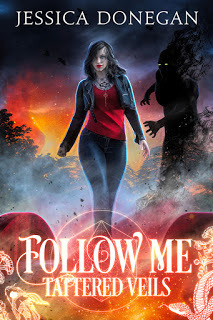 image by J. Caleb Design all rights are mine
image by J. Caleb Design all rights are mineThe Roxi on the cover of my novel doesn’t match how I describe Roxi in the book. Today I will go through the differences and explain how they came about.
Spoiler alert, it has NOTHING to do with my cover artist. J. Caleb Design did amazing work. He is patient, open, and easy to work with. He would have adjusted whatever I wanted and made it look good.
Roxi has blue eyes on the cover and brown in the book.— blue eye color pops with the background and brown doesn’t, yeah it’s that simple.Roxi has tattoos on her chest, while book Roxi only has tattoos on her arm, shoulder and back.—Roxi is wearing a cool jacket and the only way to communicate her tattoos from this pose was to have put them on her chest. Yes, I could have asked for another pose or outfit, but the whole appearance seemed fitting and I didn’t want to make major changes to artwork that was working. Anyone who’s tried to get cover art knows sometimes changing the smallest thing ruins it and can leave you feeling "how do I to fix it?”Roxi’s tattoos are draw in black line work on the cover but in the book they have full color descriptions—The black line work stands out as color would not in this cover. I suppose I could have used a dark background and brightened Roxi’s image with color tattoos, but it would have messed with how the title and my author name pop, and it was just cleaner to suggest the true nature of her tats over showing it. Roxi’s hair is shorter on the cover vs the book description—I tried a character with longer hair, it took away from the sense of movement this character has AND it made Roxi look unapproachable, which is something she may desire but is not a great look for a main character to sport on a cover. I kinda loved that cover design but EVERYONE else HATED Roxi and found her unapproachable in that character design… I learned a lot about me and my internal perspectives in this process.The bridge Roxi’s walking over is a real place (Big Spring Park’s Japanese Friendship bridge) and it has railing—Again tried a cover with a railing, it was cool but too busy. Put emphasis back on Roxi by lowering the bridge.Overall, I think my cover captures the spirit of the book, even if it lacks a photo realistic representation of its contents. What do you think? Should I have made Roxi’s image match my descriptions? Do you like the cover, or would you have gone a different way? Should Roxi even be on the cover?
Published on February 04, 2020 10:13
February 2, 2020
Roxi's Imbolc
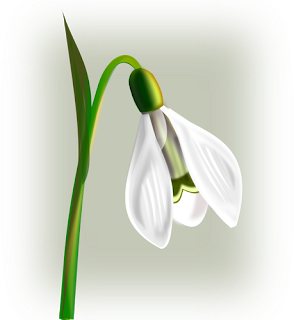 Snopdrop flower found through
pubaicdomainvectors
.org
Snopdrop flower found through
pubaicdomainvectors
.org
Below is an Imbolc Celebration as my main character Roxi from "Follow Me: Tattered Veils" may celebrate the day. It's a fun little extra and I hope it helps introduce readers to Roxi before the release of my novel. Feel free to look at a full summary of "Follow Me: Tattered Veils" here.
Roxi wakes up an hour before dawn to prepare her shrines. The coffee table holds her ceremonial tools including a pomegranate and a stone to honor Persephone. Roxi lights a small fresh votive and picks up the pomegranate. Deep breathe in and Roxi closes her eyes and feels the fruit’s thick skin. It’s firm, free of the mushy bruises that mark so many others. Red-pink skin feels smooth and subtle under Roxi’s fingers, there’s something rich and compelling with its color and texture. Roxi imagines goddess Persephone cradling a fruit just like this. Deep within Hades, what did this deep color mean to her? Deep red like blood and a living fruit like those her mother Demeter tended—did it remind Persphone of the life on the surface Hades stole her from? Did she think the servant boy offering it to her, handed her comfort? The Pomegranate is so large, Roxi needs both hands to hold it and she wonders if Persphone’s perspective mirrored her own.
Roxi cuts into its skin to reveal the white waxy flesh hiding below the surface. Blood and bone have such strong grave connotations Roxi wonders how Persephone missed them.
But then, blood and bone also connect us to life, to this material world. Perhaps Persephone has spent so much time with immaterial spirits she was relieved to know something of the physical world again.
It takes care to peel away the skin, protecting the fragile seeds like foam egg crates do precious cargo, but Roxi plucks the seeds out whole and undamaged. She admires the transparent ruby shine each seed holds. Its own little world. Which ones would grow and which would rot? Infinite possibilities at this phase.
The red pill. No going back from here.
Half of the seeds go onto a metal leaf offering plate with a handful of almonds. Roxi keeps the other half in a wooden bowl in front of her.
“For you, my kindred, let’s travel together. We knew darkness and limbo. Sat in the spirit realm, in a state beyond time and touch. But now it’s time to ascend: to know rebirth. Even as we eat the fruit of death, let’s celebrate it richness. It has a bright surprising tang on our tongue. Instead of looking at shadows, let’s see the natural cycle as it is, and death is a necessary step to all life. The wheel with turn and with it, we will have to face our end. But today is for new beginnings. I offer almonds to celebrate our freedom, maybe enjoy the warm sun on our faces and cooling rain that will run through our hair,” Roxi prays.
She eats her meal cross legged on the floor. The room is dark, lit only by a single votive candle. Roxi feels the energy build alone with the small light. She imagines herself next to Persephone in Hades, shrouded in darkness and fog, the votive mimics the sun slipping over the horizon. It guides her through a jagged path to the surface. Roxi like Persephone, waits for the sun to rise and lead her back to the mortal realm.
Outside, Roxi hears the loud songs of returning songbirds. For the moment she tries to keep her mind focused on the dark and the pomegranate seeds. These are her last moments living in quiet reflection. In only minutes now, she will change. Her life restarts and instead of tarot readings and long nights reflecting on the past year, Roxi will turn her face to the sun, taking action, and filling her life with all her favorite activities. The very prospect thrills Roxi and sends rushing bolts of energy through her. She might need to time to process her life and plan, but she is not by nature one for self reflection. If she had her way, Roxi would leap full force from project to project and never look back at the destruction and chaos she leaves strewn behind her.
Roxi rises and head to her fridge. She’s kept a wreathe of fresh narcissus and lilies for the occasion. Roxi adorns Persephone’s statue with the wreathe.
“Welcome back to the light and the world of the living. Let these flowers, at their height of vitality inspire you to new heights of exploration and joy,” Roxi says.
She lights a lavender pillar candle near the statue. She dips her fingers in a bowl of fresh olive oil. Roxi anoints the statue’s forehead and lips. She feels energy swirl and tingle around her. Roxi visualizes the power filling her and helping her “grow” roots down to the earth below. The energy settles around her statue of Persephone and Roxi knows the goddess accepts her offering and will remain close to her for another spring. She smiles despite how serious the moment should be. Knowing she’s connected with the young goddess and renewed their standing contract, brings too much pleasure for her hold it all in, even if there’s also a weight of obligation that comes from working with any deity. Enshrined in energy and the “proof” of her own faith, Roxi feels the world re-awaken around her. She opens her arms in welcome as she envisions crocuses budding and robins foraging on her lawn.
“Demeter greets you in joy and love. With you comes her kindness. She softens and warms the soil so your bare feet make walk the earth in comfort. Return to the land and grow in light and love,” Roxi prays.
This is the last day this statue will reside in her center table. Tomorrow Roxi will break down the little shrine and the Persephone statue will return to its top corner in her hutch in the study. Another deity will take over Roxi’s central worship. She’s still uncertain what will call her next.
Roxi walks back toward her kitchen, to the sun room, and out her sliding door to the outside. It’s too cold for Roxi to be barefoot in short sleeves, yoga pants, and a pastel wrap, but her traditions require it. She shivers as her feet numb from the chill of the cement. One deep breathe in and another out. Roxi refuses to shiver, if she starts, she’ll never stop. Her hands have to be steady for the rest of her ritual work.
Candles cover the outdoor seating area. Roxi’s pots with narcissus and crocuses are out and exposed to the chill air. She’s been growing in the study, so no matter the weather, they’d be ready for her Imbolc ritual. Budding but not in bloom, Roxi wants them to linger in early growth until the Spring Equinox. Some of them will flower early but Roxi’s picked a bulb plant that blooms 2-5 weeks after it buds, so she imagines some of them will flower just in time to greet spring. It brings her a bubble of pride to see all her planning come together for her holidays. Life on earth may have happened by a divine cosmic accident, but that’s all the more reason to celebrate the natural ebb and flow. Isn’t it miraculous there’s any life to celebrate, let alone such a vibrant one? And humans, so removed from natural cycles, need to plan more than most creatures if they want to return to that nature. Roxi’s made the effort.
On her third breathe in, Roxi turns to the east. Her fence is too tall for her see the sunrise, so she has to imagine the rising sun. She pictures a flat endless horizon where the flaming sun peaks over the dead brown grass. She pictures in her mind’s eye how this is the beginning. The earth is still in slumber with all the green in deep hibernation. The days are too short and the weather is still harsh, but the sun is rising and dawn is coming earlier and earlier. The golden warmth is chasing the chill of winter. The grass may feel frail and contain an almost uniform dead brown coloration but deep searching will show strands of green fighting through to the light. The gray clouds shouldn’t be discounted as a depressing veil, instead Roxi must consider the hydrating rain that falls from those heavy clouds. Soon enough the rain will end and Roxi can dance below azure skies. Alabama is a lush wild green with vines that weave and snake through each other competing for attention, space, and resources. Roxi feels the power of this time marching to the forefront and pulling her along in its wake. This sunrise is like the very beginning of a tide coming in.
Roxi walks around her patio lighting every candle and outdoor torch. It floods the area with light, mimicking the light the sun will soon raise across the land. Roxi takes blessed water and sprinkles it over each narcissus and crocus. She moves one arm to form a pentacle blessing over each pot.
While this is a greeting of the sun and Catha, a sun goddess would be a natural choice for this celebration, Roxi shies from her. She is pledged to Artemis, a Goddess of the moon and hunting, leaves her wary of celebrating the daylight too strongly. Instead, Roxi calls on Menfra, a goddess of dawn, dusk, craft, and industry to celebrate the coming dawn and her a period of her life meant to focus on refining her skills and talents.
“Menfra, welcome this world and bring your warmth earlier each morning while you bear the darkness later in the evening. Bless us with plentiful materials to inspire great personal and natural growth. You lead us to light and to our passions. May you illuminate a rich and meaningful path for me in this new year,” Roxi prays.
She picks a hammer decorated in lavender and cream colored ribbons along with a large iron ceremonial nail arranged on a nearby table for her. Roxi walks through her garden and to her fence. In the back most eastern corner is a fence post with a new nail added in each year.
“With this act, may I nail in a year full of vibrant new challenges, joy and growth. May my fortune be filled with deep experiences and rich in meaning. Let my path be clear and continue to take me where my gods wish me to go,” Roxi beseeches. She places the nail on the post and hammers it in. She pictures a silver sparkling waif-like hand or Nortia, the Goddess of fortune, holding the nail with her. Instead of holding the hammer in her other hand, Nortia holds a shimmering multicolored long cloth. Below Nortia’s hold it flows on as far Roxi’s eye can see and it squirms and struggles. Its colors, shape, and size shift in a way that makes Roxi dizzy. Where Nortia holds this fabric, the bright colors remain steady, and it is as stationary as a rock. She shows no effort in holding down fate, even though the riotous colors splayed beyond her reach fluctuate in such extremes Roxi can barely make out any element from one moment to moment. With Nortia’s help, Roxi knows her nail will hammer in her own fate for this year.
When Roxi is done with her work, she sends a silent thanks to Nortia. The natural light is strong now so Roxi bids a silent farewell to Menfra. Dawn is past, and it’s time to move on.
Roxi moves to her kitchen and a small shrine on her high top against the wall. Against the wall is a traditional picture of Columbia in her American flag gown and a star studded Phrygian cap. Below is a small flag on a stand, an incense holder and several local rocks and seed pods. Roxi lights a new large pillar candle below the painting. She takes a fresh incense stick scented in fresh orange blossom, almonds, and ginger. It invites the senses into the coming spring while grounding the smell with earthy textures meant to remind Roxi that spring is coming but that she is still transitioning in from the cold still winter.
She walks through every boundary and area of the house with the lit incense. She breathes the scent as it blesses every small nook and space in her home. Roxi can feel her home’s blessing and protections revive under its touch. In Spring Equinox Roxi will strengthen and reset her home’s protections and welcome, but feeling its soft glow still strong and ready makes her feel safe in her home and her life.
The rest of Roxi’s day is dedicated to blessing areas of her garden and pruning the beds. She’ll pull weeds and cut back what’s over grown, mixing action with prayer. It’s not enough to believe, right action above right thought.
Roxi will be dirty and hungry come mid-afternoon. She’ll shower, using an orange ginger body scrub. Finally warm again after long hours in the cold February air. She’ll hum “The Mummer’s dance” as she steeps tea and begins baking bread. The candles will have burnt out, but Roxi’s purpose will burn bright within her. As promised, Roxi’s house will be full of industry as she transitions from a period of reflection to action.
The bread, first of this year, will go to those less fortunate. Roxi donates it to a local shelter, but she’ll save a few loaves for herself and another for her gods. Next week she will head to Big Spring Park where she can honor her local land god in their chosen place.
It may make her a bad follower of Artemis, but this is Roxi’s favorite time of year. She loves stepping out of long dark nights into a fresh dawn. There’s so much promise in these early days, and the nights are long enough to still surround her future in dark mystery that keeps Roxi curious and pushing for more.
The potential is always more interesting than the reality, but it’s nice to live in hope.
Published on February 02, 2020 15:37
January 28, 2020
If You Like "Lost Girl" You Might like My Novel (spoilers for the show—not my novel)
This
 Lost Girl, a promotional image found via google images.
Lost Girl, a promotional image found via google images.
VS
This Follow Me: Tattered Veils wide image art work created by Jake @ J Caleb Designs
Follow Me: Tattered Veils wide image art work created by Jake @ J Caleb Designs
Lost Girl: A supernatural drama tv show spanning five seasons from 2010 to 2015. The show features a female protagonist, Bo, moving constantly to hide from her past. First episode she discovers she’s a fae (specifically a succubus) and part of a secret magical society living alongside humanity. Bo struggles to understand the rules of this new society and find her place in either a human or fae society. Throughout the seasons Bo gains friendships and loyalties of many around her. These relationships teach Bo more nuances in fae society but also set her on a path to seek a more just and fair system for all fae and humans. For more details check out the Wikipedia article.
What does this series and Follow Me: Tattered Veils share?
A surprising amount. I found this show in 2015 and was hooked. There is so much in it I want in my media (and therefor was building into my novel). If you're looking for an urban fantasy with attitude and heart, I can't recommend Lost Girl enough.
Both works feature a strong female protagonist who embraces both “feminine wiles” and more physical strength as needed. Bo, as a succubus is far more sexual than Roxi, where Roxi relies more on brute force. It’s unexpected for a petite woman in heels to punch first and ask questions later and Roxi takes full advantage of this surprise to spend less time with people she’s decided aren’t worth oxygen. I love that both Bo and Roxi are honest in their relationships and don't hesitate to let others know when they've crossed a line.
Bo and Roxi both start their journey as outsiders. They've decided various aspects of the society they live in are stupid or unjust, and neither have the patience to work "within the system" for change. Instead both choose to live outside the prescribed social system.
Both characters struggle to connect with others around them. The two tend to pick up "strays" or fellow disenfranchised people/fae, become protective of these people, and then strive to make changes in their respective worlds for these people they've begrudgingly come to care for.
Both Follow Me: Tattered Veils and Lost Girl have dramas focused on many various kinds of fae. Lost Girl fleshes out the fae using different categories and names to explain why some fae are sensitive iron and others song. If Follow Me: Tattered Veils were a longer format, it would also categorize fae and explaining the contrary reactions some fae have to the same stimulus. Since it’s a single novel, it leans in too many fae myths and hints at elements more explicit in Lost Girl.
Lost Girl takes place in a modern Canadian suburb and Follow Me: Tattered Veils takes place in Huntsville, AL. Both the tv show and my novel incorporate today’s technology. Our versions of fae embrace the new tech as human counterparts have. Instead of magic “breaking” technology, the two work together to build on the character’s strengths and weaknesses. Allowing technology and magic to blend is rarer in the urban fantasy genre, but can lead to unique and interesting results.
Did you love Lost Girl? Were any of these elements you loved? If so consider picking up Follow Me: Tattered Veils when it releases in February. Check out my website jessicadonegan.com for more details.
Haven't seen Lost Girl yet but want to now? Check it out at Amazon or Netflix
 Lost Girl, a promotional image found via google images.
Lost Girl, a promotional image found via google images.
VS
This
 Follow Me: Tattered Veils wide image art work created by Jake @ J Caleb Designs
Follow Me: Tattered Veils wide image art work created by Jake @ J Caleb Designs
Lost Girl: A supernatural drama tv show spanning five seasons from 2010 to 2015. The show features a female protagonist, Bo, moving constantly to hide from her past. First episode she discovers she’s a fae (specifically a succubus) and part of a secret magical society living alongside humanity. Bo struggles to understand the rules of this new society and find her place in either a human or fae society. Throughout the seasons Bo gains friendships and loyalties of many around her. These relationships teach Bo more nuances in fae society but also set her on a path to seek a more just and fair system for all fae and humans. For more details check out the Wikipedia article.
What does this series and Follow Me: Tattered Veils share?
A surprising amount. I found this show in 2015 and was hooked. There is so much in it I want in my media (and therefor was building into my novel). If you're looking for an urban fantasy with attitude and heart, I can't recommend Lost Girl enough.
Both works feature a strong female protagonist who embraces both “feminine wiles” and more physical strength as needed. Bo, as a succubus is far more sexual than Roxi, where Roxi relies more on brute force. It’s unexpected for a petite woman in heels to punch first and ask questions later and Roxi takes full advantage of this surprise to spend less time with people she’s decided aren’t worth oxygen. I love that both Bo and Roxi are honest in their relationships and don't hesitate to let others know when they've crossed a line.
Bo and Roxi both start their journey as outsiders. They've decided various aspects of the society they live in are stupid or unjust, and neither have the patience to work "within the system" for change. Instead both choose to live outside the prescribed social system.
Both characters struggle to connect with others around them. The two tend to pick up "strays" or fellow disenfranchised people/fae, become protective of these people, and then strive to make changes in their respective worlds for these people they've begrudgingly come to care for.
Both Follow Me: Tattered Veils and Lost Girl have dramas focused on many various kinds of fae. Lost Girl fleshes out the fae using different categories and names to explain why some fae are sensitive iron and others song. If Follow Me: Tattered Veils were a longer format, it would also categorize fae and explaining the contrary reactions some fae have to the same stimulus. Since it’s a single novel, it leans in too many fae myths and hints at elements more explicit in Lost Girl.
Lost Girl takes place in a modern Canadian suburb and Follow Me: Tattered Veils takes place in Huntsville, AL. Both the tv show and my novel incorporate today’s technology. Our versions of fae embrace the new tech as human counterparts have. Instead of magic “breaking” technology, the two work together to build on the character’s strengths and weaknesses. Allowing technology and magic to blend is rarer in the urban fantasy genre, but can lead to unique and interesting results.
Did you love Lost Girl? Were any of these elements you loved? If so consider picking up Follow Me: Tattered Veils when it releases in February. Check out my website jessicadonegan.com for more details.
Haven't seen Lost Girl yet but want to now? Check it out at Amazon or Netflix
Published on January 28, 2020 11:19
January 21, 2020
Honest Comparison: Pitching a Book When You Have Too
 photo of koi at Big Spring Park taken by me
photo of koi at Big Spring Park taken by me I’ve long disdained elevator pitches. “It’s like if The Shining and Anne of Green Gables had a love child.” *eye roll*.
Published on January 21, 2020 09:15
January 14, 2020
2020 Writer's Goal Tracking System
 image from publicdomainvectors.org
image from publicdomainvectors.org
I have one planner that has the personal, work, home, and writing goal all incorporated and vying for my attention. It is impossible for me to separate one part of me like the “writer” and talk only about that because it’s connected to my mental, relationship, and spiritual self. While I’m attempting to talk about my writing habit, there will be bleed over. I’m not a organized person. Those who know me best will tell you I’m on my personal time bubble. I am the LAST person they would take scheduling tips from. Even my husband is befuddled when he comes into my writing room and sees all the calendars, color blocks, and spreadsheets. “I’m very productive, just not when it comes to the dishes,” I tease him. How does it work? I have 2 planners. One shows the current week and the other looks at next week. First, I fill out my retail job hours (always changing from week to week), then I create the weekly meal plan, write a grocery list, and schedule when I will go grocery shopping. Next I make plans for the blogs, social media, and writing. After that, I try to get to work completing these plans and “leaving space” for social time, chores, and “spiritual wellbeing.”Then I use my daily planner to record how I spend my time. I take notes as needed to remind myself not only how I used the time but what I got accomplished. For example, I brag “I can write and post a blog in 30 minutes”. In actuality I can write the draft of 3 blogs in an hour and a half then edit, schedule, tag, and find a picture in another hour and a half. Real talk: I either need more time for blogging or I need to blog less. But I would never know that without my daily planner recording how long things take.My daily planner also includes when the sun rises and sets, what day it is in my made up time flow (a system I’ve used for five years), the moon phase, and an inspirational quote—I write all of this in by hand about a month in advance. It makes for a pretty page that offers some inspiration on those grouchy days. I also have a journal where I put all the extemporaneous stuff. So things I should do, what I accomplished from week to week, what I need to work on, notes on my sigil research. Etc. MY planners have the processes and actions but my journal has all that secret stuff I’m testing and not ready to share. My journal is full of thoughts I might want to keep and reflect on where most of the planner stuff will end up being recycled at the end of the year.
Each week I review "wins" and "opportunities." I adjust the next week's plans based on last week. Then I review each month and decide the three things that went the best and three things that went the worst. I trouble shoot the areas that didn't go well, and tweak my plan for the best outcome.I’m not good with time, never that, but I am getting better. This year, I look forward to sharing some of my pages and successes and shortcomings. If you are interested in seeing my pages in action, keep an eye out on my Facebook or Instagram page, as I plan to post pictures there.Talk to me! Do you follow a calendar that’s different from a western one? Have you ever created your own organizational system? Why, what did it look like? What was important for you in making it?
Looking for more planning goodness? See my personal 2020 writer's goals. I also have advice on how to plan your first draft and a post on a online goal planner, Habitica and how it might help writers.
Published on January 14, 2020 08:46



